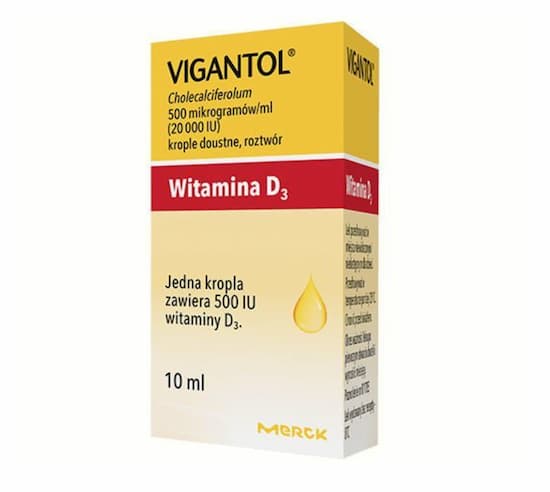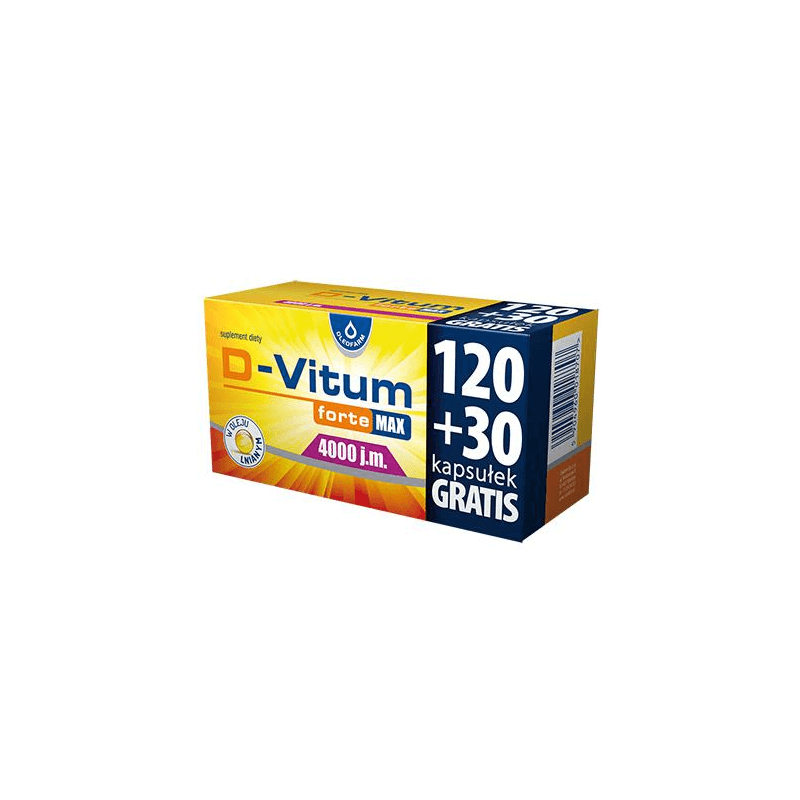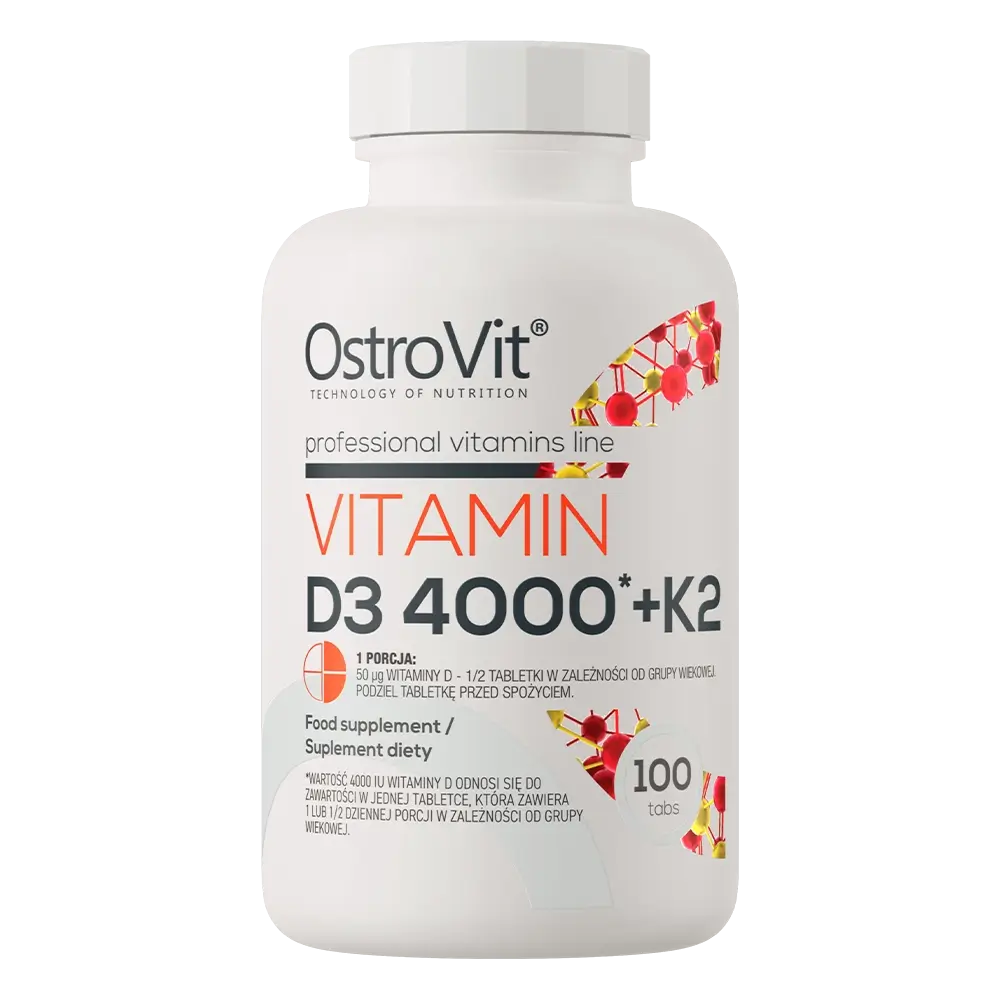Vitamin D3 - action, dosage, supplementation
Knowledge about vitamin D3 ... in a nutshell. Find out what properties it has, how a deficiency manifests itself and when it is worth supplementing.


Learn more about our editorial process
.

Learn more about our editorial process
.

Learn more about our editorial process
.

Learn more about our editorial process
.
Why you can trust us
Articles on Natu.Care are written based on scientific research, data from government websites and other reliable sources. The texts are written in cooperation with doctors, nutritionists and other health and beauty experts. Articles are reviewed before publication and during significant updates.
.Learn more about our editorial process
.Information about advertisements
Content on Natu.Care may contain links to products from the sale of which we may receive a commission. When creating content, we adhere to high editorial standards and take care to be objective about the products discussed. The presence of affiliate links is not dictated by our partners, and we select the products we review ourselves completely independently.
.Learn more about our terms and Conditions
.Vitamin D, or the 'sunshine vitamin'. Sunbathing would seem to settle its replenishment in the body. Unfortunately not in this latitude.
Vitamin D is a unique vitamin (or rather a prohormone) that up to 90% of Poles may be deficient in. And it is crucial for your health. Together with a clinical nutritionist, we will introduce you to everything you need to know about vitamin D.
In this article you will find the following information:
.- D vitamins - a breakdown .
- Properties of vitamin D3 .
- Where is vitamin D3 found .
- Vitamin D3 deficiency .
- Symptoms of deficiency .
- Vitamin D3 overdose .
- Testing vitamin D3 levels. When is it worth getting tested .
- Supplementation: dosage, contraindications, forms of administration .
- Contraindications to the use of vitamin D3 .
- How to ensure correct vitamin D3 concentrations .
- Vitamin D3 in capsules or drops? Which is the best? .
- Vitamin D3 in cosmetology .
- Vitamin D versus COVID-19 .
- Summary .

Zobacz, co dla Twojego zdrowia może zrobić Natu.Care Witamina D 2000 IU. -15% z kodem BLOG15
Natu.Care Witamina D 2000 IU
Natu.Care Witamina D 2000 IU wspiera prawidłowe działanie układu odpornościowego, utrzymanie zdrowych kości i zębów oraz utrzymanie prawidłowych funkcji serca, nerek i układu mięśniowego.
Sprawdź cenę
Świetny produkt, tabletki są małe i wygodne do połknięcia. Plus za wysoką jakość!Joanna
.
- Vitamin D3 drops .
- Vitamin D3 [ranking] .
- Vitamin D dosage + standards and recommendations .
- Vitamin D3 K2 whether you need to combine them + expert opinion
- What is vitamin D? Sources, table, examples
- Vitamin D deficiency symptoms + treatment
- Vitamin D overdose
- Maximum vitamin D dose, or what kind? Expert opinion] .
D vitamins - breakdown
.
Let's put the knowledge in order. Wondering if vitamin D and D3 are the same thing? Vitamin D is not a homogeneous substance. When we write about vitamin D, we are referring to a group of fat-soluble organic chemicals.
Two forms of vitamin D are of primary importance to humans:
.
-
Vitamin D2 (ergocalciferol), found in plants and fungi.
-
Vitamin D3 (cholecalciferol), found naturally in skin tissue of humans and animalsand.
The primary natural source of vitamin D is skin exposure to sunlight (UVB). Hence the popular nickname for vitamin D - the 'sunshine vitamin'.
Vitamin D2 or D3? Which is better?
.
As suggested studiesand, vitamin D2 is less effective than vitamin D3 in raising serum vitamin D concentrations. It is cholecalciferol that raises the concentration of this vitamin higher and for longerand. Furthermore, vitamin D3 has better biological efficacy, bioactivity and stability compared to vitamin D2.
Vitamin D3 - vitamin or prohormone?
.
Technically speaking, vitamin D3 is not a vitamin but a prohormoneand because it is synthesised endogenously in the skin. However, vitamin D3 also meets the criteria of a vitamin per se, as people can meet their requirement for it through diet. Hence the term vitamin D3.
Properties of vitamin D3
.
Vitamin D3 has important effects on:
.
- Calcium and phosphate metabolism : it contributes to the absorption of calcium in the gut, which strengthens bones, prevents fractures, osteoporosis and rickets in children .
- Immune system: supports our immunity to fight infection, increases production of microbial-fighting proteins .
- Muscular system : strengthens muscles, promotes muscle recovery after exercise .
- Neural system: plays a beneficial role in brain development, may prevent dementia and Alzheimer's disease .
- Cardiovascular system: reduces the risk of cardiovascular diseases e.g. hypertension, heart disease .
As you can see, vitamin D3 has a huge impact on the functioning of the whole body. This is why it is so important to maintain its optimal concentration. So, it remains to explain...
.
Where does vitamin D3 occur?
.
Exposure to the sun
.
Production of vitamin D3 in the skin through sun exposure is its primary natural source. This covers as much as 80-90%and the daily requirement. However, the amount of vitamin absorbed can vary considerably.
The following factors reduce exposure to UVB light and thus reduce the absorption of vitamin Dand:
.
- .
- Applying sunscreen correctly can reduce absorption by up to 90%, according to some studies.
- Wearing full-length clothing that covers the entire body.
- Wearing full-length clothing that covers the entire body.
- Limiting the amount of time spent outdoors. .
- Darker skin tone (due to higher pigment melanin content) acting as a natural sunscreen. .
- Some seasons and living in northern latitudes above the equator, where UVB light is weaker.
Important!
.UVB radiation does not penetrate glass, so exposure to sunlight indoors or in a car does not produce vitamin Dand!
Diet rich in vitamin D3
.
We can also supply the sunshine vitamin to the body from food. In this way we are able to cover about 20% of the daily requirement.
Sourcesand food sources of vitamin D3:
.
- .
-
fish: salmon, swordfish, tuna, sardines, rainbow trout, eel,
. -
egg yolk,
.
-
beef liver,
.
-
Cheeses: yellow (gouda, edam), moulded (gorgonzola, brie), matured (camembert, cheddar),
- cheeses.
-
milk;
.
More and more food products enriched with vitamin D are appearing on the market, such as dairy products (yoghurt), baked goods, vegetable drinks or cereals (breakfast cereals).
The following are some of the most important nutritional benefits.
See also:
Vitamin D3 deficiency
.
Production of vitamin D in the skin is the main natural source, but many people have a insufficient concentration of itand.
Who is at risk of vitamin D3 deficiency?
.
- Inhabitants of regions where sunlight is limited in winterand. .
- Persons with limited sun exposure due to being indoors most of the time. .
- Persons with darker skin because the pigment (melanin) acts as a shade, reducing vitamin D production .
- Persons using sunscreen .
- Persons with dairy, egg intolerance or on a vegan diet .
- People over 65 years of age - the skin's ability to produce vitamin D decreases with age .
- Newborn babies - due to their intensive growth and the fact that breast milk contains a small amount of vitamin D. In addition, with each month, the diet becomes poorer in vitamin D-enriched products (porridge, modified milk) .
- People who are overweight . .
- Smokers . .
- Patients taking drugs that affect vitamin D3 absorption, e.g.: cholesterol-lowering drugs, anti-epileptic drugs, glucocorticoids, antifungal drugs, HIV/AIDS drugs .
- Persons who have been diagnosed with:
- chronic disease kidney disease or liver , .
- thyroid diseases : hypothyroidism, hypothyroidism, Hashimoto's,
- asthmaand bronchiolitis, .
- atopic dermatitis ,
- hypertension arterial, .
- ischemic heart disease ,
- disorders of digestion, malabsorption, chronic inflammatory bowel disease ,
- obesity, overweight ,
- diabetes , .
Symptoms of deficiency
.
Vitamin D3 deficiency can be difficult to spot, as symptoms may not appear for several months or years. Sometimes there are no symptoms at all. With this in mind, it is still useful to know what should trigger your vigilance.
Vitamin D3 deficiency symptoms:
.
U adultsand:
- Frequent infections, recurrent colds. .
- General fatigue. .
- Bone pain.
- Pain.
- Weakness, muscle aches or cramps. .
- Mood lowering, apathy, depressive moods. .
- Sleep problems (insomnia, decreased quality and length of sleep). .
- Long wound healing time. .
U childrenand:
- Bone pain, especially in the lower limbs, which may awaken the child from sleep at night.
- Bone pain.
- Muscle pain, muscle weakness.
- Muscle weakness.
- Deformity: growth retardation, valgus knee, knee scoliosis.
- Deformity: growth retardation, knee valgus, knee scoliosis.
- Delayed ability to walk. .
- Calcium imbalance: tetany, cardiomyopathy, seizures. .
Learn more:
Vitamin D3 overdose
.
Luckily, overexposure to the sun does not cause a vitamin D overdose because the body limits the amount of vitamin D it produces. An overdose of vitamin D can occur if we take too large an amount of dietary supplements. Vitamin D toxicity is quite rare, but can lead to hypercalcaemia (too much calcium in the blood)and.
Symptoms of vitamin D3 overdose
.
Too much vitamin D3 causes the following symptoms :
- headache, .
- nausea, .
- vomiting, .
- increased thirst and urination, .
- deterioration of appetite, .
- weakness, .
- ataxia (a neurological condition that can cause slurred speech and stumbling), .
- disorientation, .
Overdose - what to do? How to treat?
.
If you suspect a vitamin D overdose, see your doctor immediately. Usually, depending on the patient's condition, treatmentand includes stopping vitamin D supplementation and limiting calcium in the diet.
The doctor may also prescribe intravenous fluids and medications such as corticosteroids or bisphosphonates. The patient should review the list of their medications, supplements to adjust future vitamin D doses and avoid excesses of this vitamin.
Patient's list.
See also:
- Vitamin D overdose [symptoms + effects + what to do] .
- Maximum dose of vitamin D [what + expert opinion] .
Testing vitamin D3 levels. When is it worth getting tested?"
.
If you suspect you have abnormal 'sunshine vitamin' concentrations, talk to your doctor about the risks and symptoms. Your doctor may make a referral for a reimbursable serum test for this vitamin.
Blood test - what does it look like?
.
You will receive a referral from your specialist for the free test. We can test for vitamin D3 in the body using two parametersand:
- .
- 25(OH)D3 - the test consists of determining the concentration of total 25-hydroxy vitamin D: calcidiol [25(OH)D] and other hydorksylated derivatives. This test is the most commonly ordered. It reflects very well the amount of vitamin D from diet and skin synthesis. .
- 1,25(OH)2D3 - test involves determination of active vitamin D, does not reflect the actual status well. It is only available for strictly defined medical indications and requires a more complicated procedure.
You can also have the test done privately. Prices depend on the laboratory and start from £75. You must inform the medical staff of any medicines, supplements and herbal preparations you are taking. We do not need to be fasting. Blood is taken from the elbow vein. You will usually receive the result within 1-3 days.
See also:
.
Vitamin D3 standards - results
.
Are there different blood vitamin D3 standards in adults and children? The following standardsand are the same for each age group!
.
|
Results . |
Level . |
|
0 - 10 ng/ml* |
severe deficiency |
|
10 - 20 ng/mL |
significant deficiency |
|
20 - 30 ng/ml |
suboptimal |
|
30 - 50 ng/ml |
optimal |
|
50-100 ng/mL |
high |
|
> 100ng/ml |
toxic |
*nanogram/millilitre
.
Please remember to always refer to the range and units of the laboratory in question.
Supplementation: dosage, contraindications, forms of administration
.
Dose selection by age group depends on:
.
- body weight, .
- stage of sunshine (season), .
- nutritional habits, .
- diseases and general health status, .
For this reason, the dose should be set individually. In the guidelines, you will only find ranges within which vitamin D should be dosed, not strict determinants.
Natu.Care Vitamin D 2000 UI
Product description
Vitamin D plays a crucial role in our health and well-being. It affects calcium and phosphate metabolism, which translates to healthy bones and teeth. It also helps regulate the immune system, and studies indicate its influence on the functioning of the nervous system.
Vitamin D, although called a “vitamin,” is actually a prohormone that our body produces on its own, primarily under the influence of sunlight. Unfortunately, our modern lifestyle contributes to deficiencies of this essential vitamin. Working in enclosed office buildings, using (necessary!) SPF creams, and covering the body with clothing all make it very difficult, if not impossible, to obtain adequate levels of vitamin D from sunlight. This is why appropriate, year-round supplementation is so crucial.
Vitamin D from Natu.Care is a well-tested vitamin D3 suspended in safflower oil, a plant known for its numerous health benefits. The convenient, easy-to-swallow capsule will make supplementation a part of your daily, healthy routine, improving your overall well-being.
Pros and cons
Pros:
- Ensures proper functioning of the immune system
- Supports the maintenance of healthy bones and teeth
- Maintains proper heart, kidney, and muscle function
- Tested by an independent, certified laboratory
- Convenient and easy-to-swallow capsule
- Clean composition - free from added sugar, gluten, GMOs, lactose, and without preservatives or colorants
Cons:
- None.
Additional Information
Pregnant women and breastfeeding mothers should consult a doctor before using the product. This dietary supplement is intended for a healthy adult population up to the age of 75.
OstroVit Vitamin D 4000 IU

- Content vitamin D3: 4000 IU
- Form: capsules .
- Dose: 1 capsule per day .
- Sufficient for: 120 days .
Product description
OstroVit Vitamin D 4000 IU is a dietary supplement in the form of soft capsules, specially designed for peopleóing vitamin D deficiency, and especially recommended for seniorsów.
.Contains 4,000 IU of vitamin D per capsule, enabling effective dietary supplementation. The olive oil contained in the formula enhances the absorption of vitamin D, further enriching the supplement with healthy fats.
The supplement contains a wide range of vitamins and minerals.
The pack contains 120 capsules, allowing for four months of supplementation when taken with one capsule per day.
Pros and cons
OstroVit Vitamin D 4000 IU is a dietary supplement in the form of soft capsules, specially designed for peopleóing vitamin D deficiency, and especially recommended for seniorsów.
.Contains 4,000 IU of vitamin D per capsule, enabling effective dietary supplementation. The olive oil contained in the formula enhances the absorption of vitamin D, further enriching the supplement with healthy fats.
The supplement contains a wide range of vitamins and minerals.
The pack contains 120 capsules, allowing for four months of supplementation when taken with one capsule per day.
Additional information
OstroVit Vitamin D 4000 IU is a dietary supplement in the form of soft capsules, specially designed for peopleóing vitamin D deficiency, and especially recommended for seniorsów.
.Contains 4,000 IU of vitamin D per capsule, enabling effective dietary supplementation. The olive oil contained in the formula enhances the absorption of vitamin D, further enriching the supplement with healthy fats.
The supplement contains a wide range of vitamins and minerals.
The pack contains 120 capsules, allowing for four months of supplementation when taken with one capsule per day.
Dr. Jacob's Vitamin D3 drops
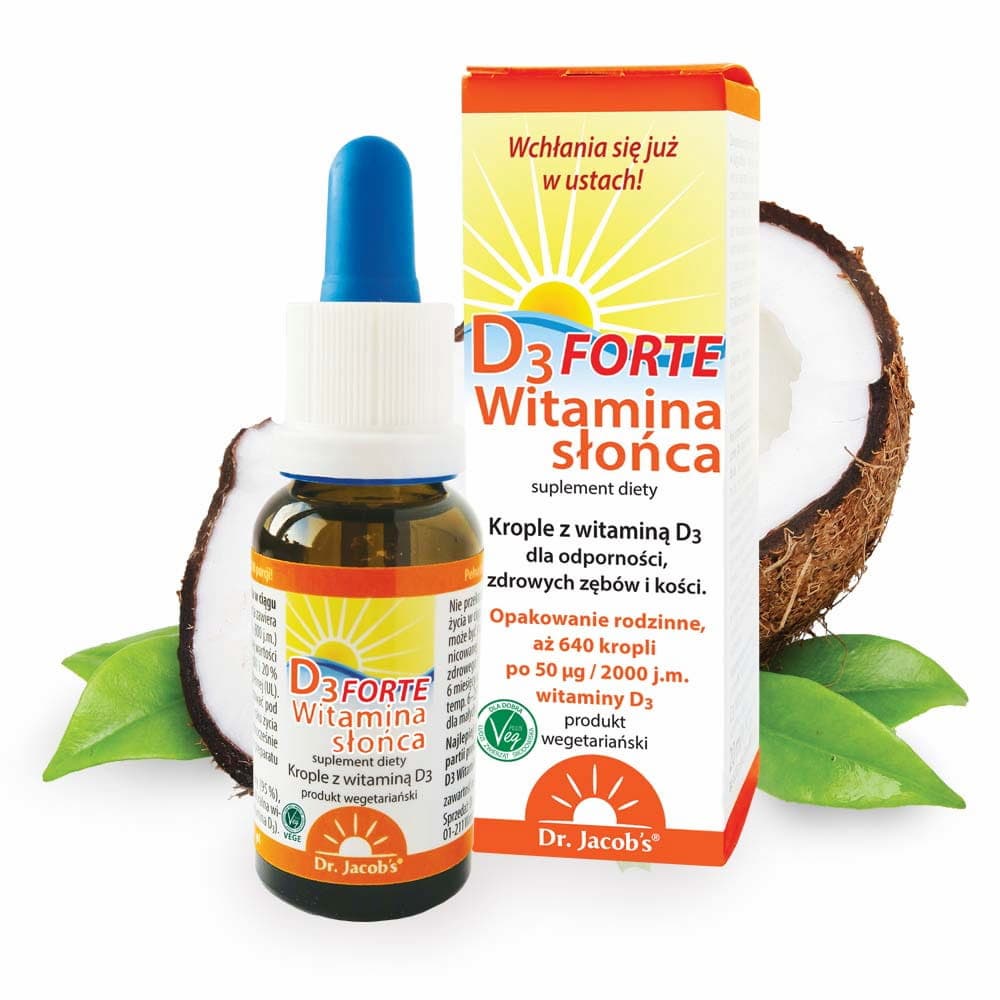
- Content vitamin D3: 800/1600 IU
- Form: drops .
- Dose: 1 or 2 drops daily .
- Sufficient for: 320–640 drops .
Product description
Sunshine Vitamin D3 FORTE is a dietary supplement containing a high dose of vitamin D3. Each drop of the product provides 800 IU of this essential vitamin for the proper functioning of the organism, whichóra supports the proper absorption of calcium and the maintenance of healthy bones, teethóra and muscles.
Pros and cons
Sunshine Vitamin D3 FORTE is a dietary supplement containing a high dose of vitamin D3. Each drop of the product provides 800 IU of this essential vitamin for the proper functioning of the organism, whichóra supports the proper absorption of calcium and the maintenance of healthy bones, teethóra and muscles.
Additional information
Sunshine Vitamin D3 FORTE is a dietary supplement containing a high dose of vitamin D3. Each drop of the product provides 800 IU of this essential vitamin for the proper functioning of the organism, whichóra supports the proper absorption of calcium and the maintenance of healthy bones, teethóra and muscles.
Vigantol witamina D3
Product description
Vigantol has been trusted by Poles for years. It is an over-the-counter medicine that you can buy at a good price at any pharmacy. It has a simple composition, without unnecessary additives and a small package that will fit into any home medicine cabinet.
Why is it worth it?
- The status of the medicine guarantees us the highest quality of the active ingredients, certainty about the dose and the effect of the preparation until the expiry date.
- Vigantol has an advantage over other over-the-counter vitamin D3 medicines because of the form of the drops.
- The drops are better absorbed by the body and do not need to be taken with a meal (unlike, for example, Vigantoletten, which is in tablet form and is recommended to be taken with a fatty meal).
Take note
- The bottle does not have a convenient dispenser. To measure the four recommended daily drops, turn the bottle upside down. The drops dispense slowly. When the liquid runs out, it is difficult to empty the bottle "dry" - a little is left inside.
- If the dispenser becomes clogged, gently tap the bottom of the bottle against the surface (tabletop, table) and then dispense the drops.
- You can use Vigantol for children, bearing in mind that 1 drop is 500 IU, and this is the requirement from the age of 3.
D-vitum
Product description
Oleofarm D-Vitum Forte Max 4000 IU is a dietary supplement in the form of capsules with high vitamin D content. The preparation is designed to supplement the diet of healthy adults over 75 years of age with this valuable active ingredient.
Pros and cons
Oleofarm D-Vitum Forte Max 4000 IU is a dietary supplement in the form of capsules with high vitamin D content. The preparation is designed to supplement the diet of healthy adults over 75 years of age with this valuable active ingredient.
Additional information
Oleofarm D-Vitum Forte Max 4000 IU is a dietary supplement in the form of capsules with high vitamin D content. The preparation is designed to supplement the diet of healthy adults over 75 years of age with this valuable active ingredient.
Expert opinion
OstroVit Vitamin D3 4000 + K2
Product description
A dietary supplement in tablets supplementing the diet with vitamin D and K. Vitamin D helps in the proper absorption and utilisation of calcium and phosphorus, and in maintaining a normal level of calcium in the blood. Vitamin K contributes to normal blood clotting and helps maintain healthy bones.
Pros and cons
A dietary supplement in tablets supplementing the diet with vitamin D and K. Vitamin D helps in the proper absorption and utilisation of calcium and phosphorus, and in maintaining a normal level of calcium in the blood. Vitamin K contributes to normal blood clotting and helps maintain healthy bones.
Additional information
A dietary supplement in tablets supplementing the diet with vitamin D and K. Vitamin D helps in the proper absorption and utilisation of calcium and phosphorus, and in maintaining a normal level of calcium in the blood. Vitamin K contributes to normal blood clotting and helps maintain healthy bones.
Expert opinion
Vitamin D dosage
.
The average healthy adult should take 2000 IU of vitamin D3 per day. Larger daily doses of 2000-4000 IU are recommended for people: over 75 years of age, those with autoimmune diseases, the obese and those with dark skin - as they may have reduced absorption and poorer metabolism of vitamin D3.
See what the recommendations are for you and your loved ones.
Average daily recommended amountsand
.
|
Target group . |
Dose |
|
|
Children up to the age of 6 months |
400 IU* |
|
|
Children 6 to 12 months of age |
400 - 600 IU . |
|
|
Children one to 10 years of age |
||
| . |
600 - 1000 IU |
|
|
Children between the ages of 11 and 18 |
||
| . |
800 - 2000 IU . |
|
|
Adults 18 to 75 years of age |
||
| . |
800 - 2000 IU . |
|
|
Persons over 75 years of age |
||
| . |
2000 - 4000 IU |
|
|
Pregnant and breastfeeding women |
||
| . | 2000 IU
|
*IU (international unit) - a unit of activity of biologically active substances, established by the WHO. Used to compare levels of the same active substances in a given drug.
Important
In healthy individuals spending at least 15 minutes a day in the sun with uncovered forearms and lower legs for at least 15 minutes a day between 10am and 3pm without sunscreen between May and September, supplementation is not necessary, although still recommended and safe.
Contraindications to vitamin D3
.
Contraindications to the use of vitamin D includeand:
- hypersensitivity to any ingredient in the dietary supplement (read labels), .
- diagnosed renal insufficiency or hypercalcaemia, .
- use of anticoagulants, antiepileptic drugs, drugs containing liquid paraffin, magnesium, digitalis glycosides, thiazides, rifampicin. .
How to take care of proper vitamin D3 levels?
.
- Determine if you may have a vitamin D3 deficiency/excess. Are you at risk? Consult your doctor and, if in doubt, get blood tests.
- Consult your doctor.
- In the sunny months (April - September) try to stay in the sun min. 15 minutes with 18% of your body exposed (short t-shirt and shorts), no UV filters and no cloud cover or smogand. .
- Return to the section on the presence of vitamin D3 in food. Find out which products suit you and incorporate them into your diet. .
- In autumn and winter, keep in mind a nutritious diet and you can supplement with vitamin D3. Remember to consult your doctor or pharmacist about the dose. .
Vitamin D3 in capsules or drops? Which is best?
.
There are various forms of vitamin D3 available on the market. You can choose from:
- capsules, .
- tablets, .
- drops, .
- liquids, .
- powders, .
- aerosols, .
The wide choice helps to match supplementation for, for example, a young child (convenient aerosol) or for people who do not like swallowing large capsules (liquids). Drops seem to be the best form of administration, due to assimilability and bioavailability .
The absorption of vitamin D is facilitated in the presence of fat, so for supplementation (especially hard tablet form), it is a good idea to consume it with meals containing fat. Its more efficient absorption then occurs! Healthy meal fats include, for example, avocados, nuts and full-fat dairy products..
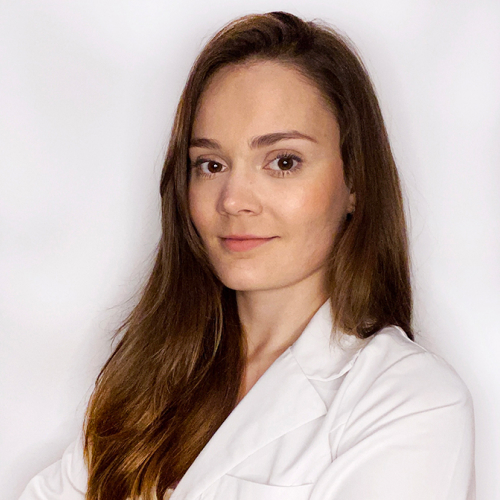 .
.
Aleksandra CudnaDietitian
.
Vegan vitamin D3
.
Vegans and vegetarians who limit their intake of animal products are at risk of vitamin D3 deficiencyand. However, supplements have emerged on the market to meet the needs of this audience. Vitamin D3 has been isolated from plant products e.g. lichens, and no zoonotic products have been used in its production .
Vitamin D3 in cosmetology
.
Sun vitamin is also used in the production of cosmetics for the face, body, hair. Its valuable skincare properties have long been appreciatedand. Regular use of cosmetics with vitamin D, among other things, soothes skin inflammation or protects skin cells against UV damage.
Vitamin D a COVID-19
.
Since the outbreak of the coronavirus pandemic, researchers have taken vitamin D under the microscope as one of the key vitamins with a huge impact on our immunity. Previous meta-analyses suggest that people with vitamin D deficiency were as much as 80% more likely to be infected with coronavirus than those with sufficient vitamin D concentrations in their bloodand.
Adequate serum vitamin D concentrations also have an impact on the course of COVID-19 infection. As shown in an interesting studyand, patients who received supplementation with this vitamin during infection were less likely to be mechanically ventilated or die after hospital admission.
Scientists continue to look at the relationship between the sunshine vitamin and coronavirus. Above all, however, they recommend that for the sake of your immunity, you should take care to exercise and eat a wholesome diet.
Sun vitamins are a good way to protect yourself.
See also:
Summary
.
- Vitamin D is actually a group of vitamins, of which D2 and D3 are the most relevant for us.
- Vitamin D3 is produced in our bodies through exposure to the sun, so it is worth ensuring regular (sensible!) sunbathing outdoors.
- Vitamin D3 is produced in our bodies through exposure to the sun, so it is worth ensuring regular (sensible!) sunbathing outdoors.
- We can also obtain vitamin D3 from diet, so plan a full meal today with healthy fats for better absorption.
- Before supplementation, it's a good idea to consult your doctor and have your serum vitamin D3 levels tested to confirm a deficiency or excess.
FAQ
.What are the symptoms of vitamin D3 deficiency?
.The most common symptoms of vitamin D3 deficiency are frequent infections, general fatigue, bone and muscle pain, muscle cramps, lowered mood, apathy, depressive moods, sleep problems (insomnia, decreased quality and length of sleep), long wound healing time. Read: Vitamin D3 deficiency
How much vitamin D3 should you take?
.The daily requirement for vitamin D3 depends on a number of factors (e.g. health status, age). The average adult should supplement with 2000 IU of vitamin D3 per day, and 4000 IU during times of higher demand (e.g. winter or in the elderly). The dosing of vitamin D3 should be discussed with a doctor.
What does vitamin D3 help with?
.Vitamin D3 helps absorb calcium and phosphorus, which is key to bone health, supports immunity to fight infection, strengthens muscles and promotes muscle regeneration, plays an important role in brain development, can prevent dementia and Alzheimer's disease, and reduces the risk of cardiovascular disease.
Does vitamin D3 have side effects?
.Vitamin D3 alone, in the correct dose, has no side effects. Consuming excessive amounts of vitamin D3 can, however, cause:
.
- headache, .
- nausea, .
- vomiting, .
- constipation, .
- increased thirst, .
- frequent urination, .
- weakness, .
- ataxia, .
- disorientation, .
Does lack of vitamin D cause depression?
.According to some scientific studies, low blood levels of vitamin D3 may promote the development of depression. Vitamin D3 can affect the production of serotonin (the so-called happiness hormone) and dopamine. It is involved in the construction and regeneration of cells in the nervous system, which is important for mental health.
Does lack of vitamin D3 cause weight gain?
.Scientific studies do not show that vitamin D3 deficiency causes weight gain, but a lack of vitamin D3 has been linked to obesity because overweight individuals have impaired absorption of this vitamin in the body.
What is the difference between vitamin D3 and vitamin D?
.When we write about vitamin D, we are referring to a group of fat-soluble organic chemical compounds. This includes vitamin D2 (ergocalciferol), found in plants and fungi, and vitamin D3 (cholecalciferol), found naturally in the skin tissue of humans and animals.
.
Sources
.See all
..
Editorials
Meet the team


Editor
Graduate of Journalism and Artes Liberales at the University of Warsaw. Since 2017, he has been working with the biggest portals in Poland and abroad as an editor. Previously worked for 3 years in one of the leading pharmaceutical companies - he knows the health and beauty industry inside out. In his free time, he most enjoys playing tennis or skiing.
![Vitamin B12 - where it occurs in the diet and in products [table].](https://cdn-resources.natu.care/uploads/1/balanced_diet_nutrition_healthy_eating_concept_food_sources_rich_vitamin_b12_cobalamin_kitchen_table_1_b84f75bda2.jpg)
Find out where vitamin B12 is found and which products will provide you with it.

Vitamin PP also known as niacin or vitamin B3 supports the proper functioning of the body.
![What is NMN? Effects, effects, side effects [supplements].](https://cdn-resources.natu.care/uploads/1/science_background_with_molecule_atom_abstract_structure_science_medical_background_3d_illustration_1_a5ec4d9cec.jpg)
Everything you want to know about NMN: properties, effects, safety and expert opinions.

